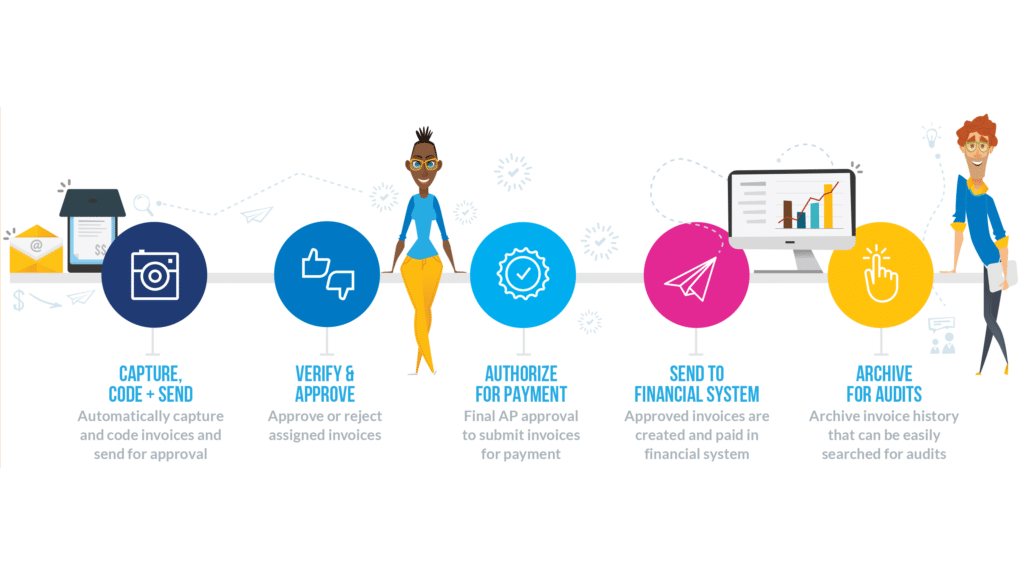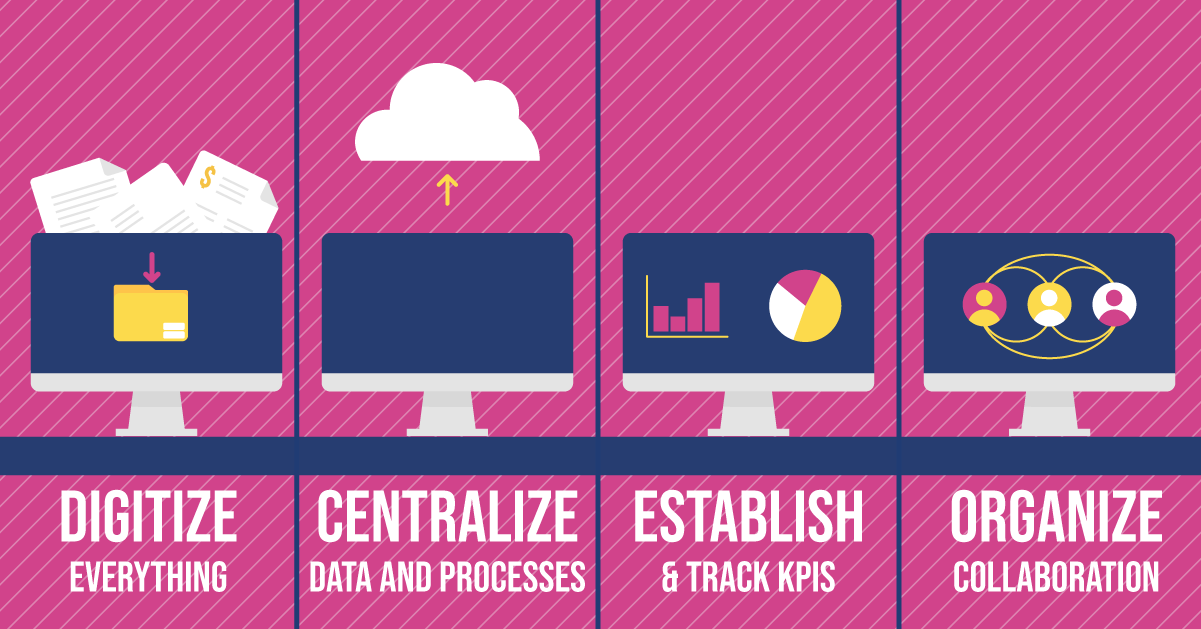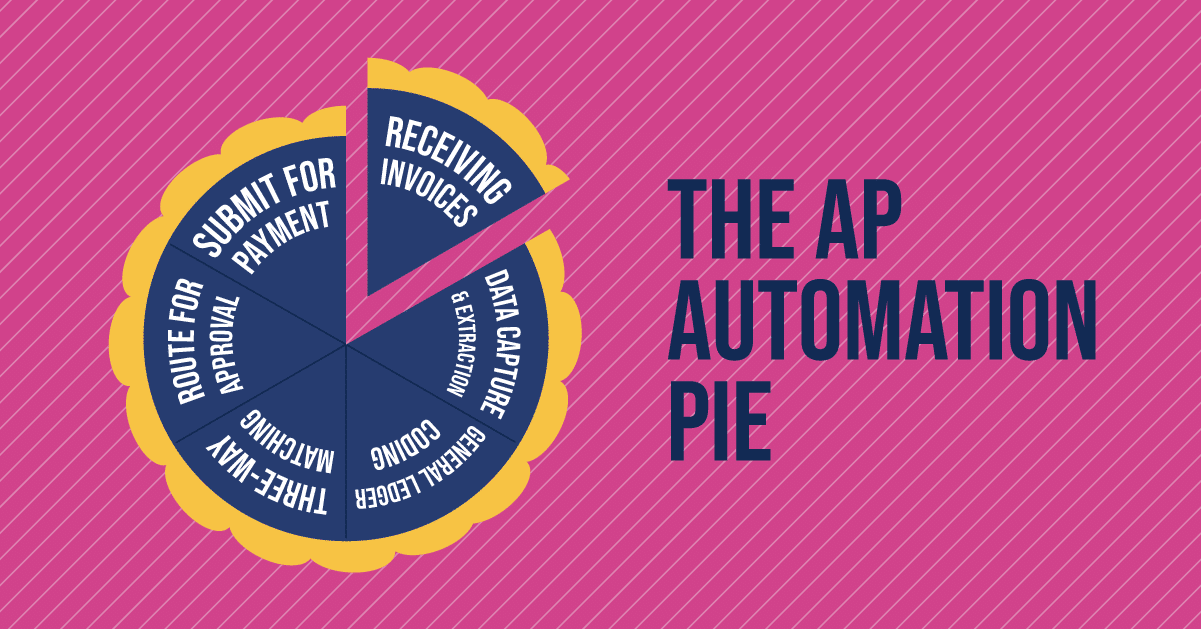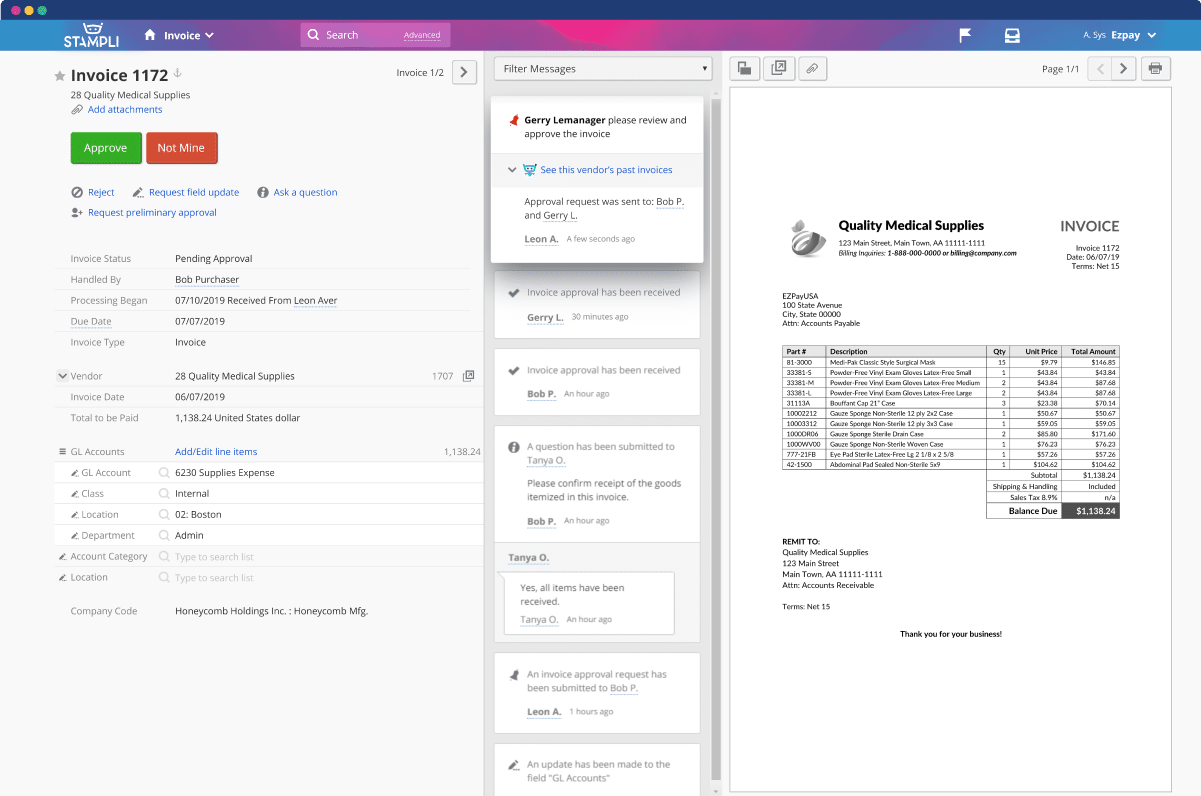What is invoice processing? Definition, steps, software & flowcharts

Invoice Processing Definition
Invoice processing by definition is a business function performed by the accounts payable department which consists of a series of steps for managing vendor or supplier invoices from receipt to payment, and recorded in the general ledger. Invoice processing is often performed with software and it is commonly referred to as automated invoice processing or invoice automation for short. An invoice processing flowchart is a structured guide detailing the steps for how accounts payable is to process vendor invoices.
Here are the steps for invoice processing:
- Capture, general ledger (GL) code, and match supporting documents such as a purchase order and/or delivery receipt
- Send invoices to authorized approvers to approve or reject invoices
- Authorize and submit invoices for payment in a financial system
- Process invoices for payment via common payment methods such as check, ACH, or wire transfer
- Archive invoices and payment information in the GL and for audit purposes
The Benefits of Automated Invoice Processing
Automated invoice processing software is used by the accounts payable department to streamline invoice processes, add more control over internal processing functions with tracking functionality, and improve the speed at which vendor invoices are processed. Automated invoice processing software is akin to AP Automation. These automated invoice processing systems help accounts payable teams automate the capture, coding, and sending of invoice for approval in addition to automatically assigning approvers and pushing invoices into financial systems for payment.
Your Invoice Processing Software Guide
In this guide, we discuss how invoice processing automation tools are enabling Accounts Payable (AP) departments to keep their current workflows and how AP technology is streamlining their existing invoice processes. If you’re looking to streamline your Accounts Payable department and save time and money for both your organization and your AP team, here’s your detailed invoice processing guide:

1. Paperless invoice processing
Manual invoice processes are typically paper-based, with AP teams sorting through and entering paper invoices by hand. Paper-based processing is slow and error-prone, and often leads to late or missed payments to suppliers.
Paperless invoice processing replaces these manual processes with automated workflows. It begins with converting paper invoices to digital formats and encouraging vendors to send digital invoices via email or a vendor portal. From there, the invoice processing software automatically scans the invoices, enters the invoice data into an accounting system or ERP, codes the invoice details, and matches the invoices to purchase orders. Once the invoices are entered and verified, the system forwards them for approval and payment.
“Since we are paperless we are not taking up any space in our filing cabinet.”
One Stampli customer says that after eliminating manual invoice processing with Stampli, they are “able to more accurately and timely record our AP expenses, and the approval process has saved us a lot of time. Coding invoices is so easy now compared to our old process of manually coding and hand-keying in our invoices…We dont have to touch so much paper. All invoices are emailed to Stampli and the software is able to read the invoice, amount etc. Invoices are getting out to additional users faster and approvals are getting done more quickly.”
2. Centralized data and processes
One of the drawbacks of manual invoice processing is that it makes it difficult for finance teams to access and use invoice data. Often, this data is buried in a spreadsheet or accounting system and can’t easily be accessed and analyzed. Even using a more advanced system like an ERP can be challenging. Many ERPs have complicated navigation, complex organizational structures and strictly controlled user roles that can make it almost impossible for AP teams to find useful information.
The beauty of paperless invoice processing (besides saving trees) is that it turns invoices into actionable data that AP teams can use to process invoices faster and more accurately. AP platforms like Stampli are easy to navigate and make it simple for AP teams to find the resources they need. One Stampli customer compares Stampli’s ease of use to SAP and Ariba, saying “[t]he interface is extremely easy to use. I much prefer this over Ariba and other SAP platforms…Stampli is solving the simplicity of what other SAP systems have yet to figure out. It is straightforward and it would be easy for anyone to pick up.”
3. Establishing and tracking KPIs
Another drawback of manual invoice processing is that it’s difficult for finance leaders to measure their AP teams’ performance, identify process bottlenecks, and track invoice processing metrics. Manually generating AP reports from spreadsheets is slow and doesn’t always provide actionable insights. Also, while many ERPs offer general reporting functionality, they don’t always provide the specific AP reports needed to monitor invoice processing performance. Often, AP teams are forced to create custom reports or find workarounds to get the information they need.
Invoice processing software platforms like Stampli automatically generate real-time AP reports and analytics and feature AP dashboards where users can check KPIs at a glance. Finance teams can use this data to make informed decisions about automation workflows, integration capabilities, and working capital management.
A cost accountant describes Stampli as a “well-designed product…[with] EXCELLENT reporting & drill-down capabilities.” Another user praises how Stampli’s reporting capability helps them maintain a complete audit trail: “My favorite thing about Stampli is how easy it is to use and how user-friendly the whole platform is. The reporting is fantastic, and the audit trail is even better. Out of all the automated AP systems I have used, this is by far my absolute favorite, and I recommend it all the time.”
4. Enabling collaboration
It’s hard for AP teams to collaborate with other business units and stakeholders when they are saddled with manual processes. Digging through emails, paper files, and voicemails is time-consuming and frustrating, especially for AP employees who are already working at capacity.
Many ERPs are structured in a way that AP teams can’t access the data, documents, or people they need to help them process invoices efficiently. One SAP ERP user describes the frustration they experience when trying to collaborate with team members: “Good software, rough user experience,” said one reviewer. “Finding the functionality you’re looking for, or the expense type you need, or adding a vendor, etc. just isn’t as easy as it should be. It’s also not readily apparent where you should go if you can’t find what you’re looking for.”
Best-in-class AP automation platforms like Stampli are designed for how AP teams work. They prioritize collaboration. For example, Stampli unifies all communications, documents, and tasks on top of each invoice so users can access the information they need and communicate with stakeholders and vendors from one screen.
A director of workforce management describes how Stampli has enabled collaboration at their organization: “Before using Stampli, the invoice management process in place lacked collaboration between all parties involved in reviewing and approving just 1 invoice. In my company, we have tens of invoices that come through a day, so it is extremely important to have a system in place that works for all levels from field staff all the way up to CFO.
Stampli has provided structure, ease & teamwork since day 1!”
Save Time and Money by Automating Invoice Processing
One huge mistake that some people make when considering AP automation is to view the system in a dichotomy—100% automated or 0% automated.

In reality, invoice processing is made up of several smaller processes, some of which will require the human touch such as approving a cost or verifying for accuracy. While others are ripe for automation like data capture and invoice approval workflows.
With that said, let’s break out some of the AP processes that are perfect for automation and provide some details about how and why. An invoice processing flowchart can also help you to identify and remove inefficiencies.
Receiving invoices
If you haven’t implemented AP automation for invoice processing yet, there’s a good chance you have invoices coming from all over the place from different departments and mediums—snail mail, faxed, email image attachments, and electronically.
We likely don’t have to tell you how much time your staff uses to gather, organize, and scan invoices and how tedious the process is, so we’ll say this instead:
If you can receive your invoices electronically, you can have all your vendor invoices sent to your AP automation system to save time on invoice receipt.
And guess what? There’s actually plenty of benefits for your vendors to submit their invoices electronically, too.
Data capture and extraction
If you have your invoices coming in electronically—great! AP automation software is uniquely suited to help capture and extract that data with no human intervention. That’s right; your staff doesn’t have to manually key in data anymore.
Manual data entry is not only tedious for your team, but it’s also time-consuming and prone to typos and human errors. On the other hand, software that’s designed to read and understand the data on an invoice is highly accurate and nearly instantaneous after learning your processes.
With Stampli, you can also capture and extract invoice data below the header, including individual or custom line items. And if for some reason your vendors aren’t sending electronic invoices yet, you can still scan your documents and Stampli will extract the data via OCR with incredible accuracy.
General ledger coding
Since you’re already using software to extract data from your invoices, why not have it code it as well? With an API integration, your AP automation platform will be synchronized with your financial system to categorize your invoices and automatically code them with your general ledger accounts.
Three-way matching
Invoice verification is a huge responsibility for the AP department—this is how we avoid duplicate and fraudulent payments. However, when approving invoices manually, verifications become time intensive, and three-way matching can be nearly impossible for invoices missing information such as PO number.
With AP automation, software can automatically read data on invoices and search its central database for corresponding data in POs or other supporting documents. Moreover, if your vendor forgot to include the PO number, you can search open POs from your integrated accounting systems with AP solutions like Stampli.
Routing and approvals invoice processing software
If the invoice is now in your system, it’s properly coded, why not just automatically send it to the person who needs to approve it? Think about the alternative:
After coding, one of your AP team members has to type out an email to a coworker in a different department, attach the invoice, then send the email… with their hands? It’s practically barbaric.
With an AP automation platform, the system aligns with your invoice processing approval workflows and all AP has to do is review any suggestions and verify. Moreover, in the case someone left the company or is on family leave, it’s extremely easy to add/remove approvers. Once routed for approval by AP, the invoice is sent to the appropriate approver(s) and in the correct order. Using automation for routing approvals, including follow-up notifications, can dramatically reduce the amount of time it takes to get an invoice approved.
With Stampli software, invoice processing is centralized where all approvals and communications happen ‘on top’ of the actual invoice, so if there’s an issue that needs to be addressed, the processor or approver can write notes within the context of the actual invoice—no more digging through separate emails to find out why something hasn’t been approved yet.

Submitting for payment
The whole reason we do what we do in AP is to ensure invoices are both valid and vendors receive payment. Which takes no small amount of effort, given the number of steps, accounts payable fraud prevention controls in place, and number of people involved throughout the invoice processing lifecycle.
So by the time you’ve gotten all the way through the long lists of tasks and everything is perfect with your invoice processes, why not just have your payment system automatically remit?
Upon successfully completing the verification and approval steps, along with the accounts payable internal controls your organization has in place, your AP automation solution should automatically be able to send the approved invoice for payment directly into your accounting system. Then when payment has been processed, updated back in your AP automation system.
Again, the choice to automate many of these tasks is a no-brainer—the computers are simply more accurate and more diligent when it comes to data extraction, etc., and not to mention your team usually loathes those types of busywork anyway!
The Quest to Improve AP Invoice Processing Efficiency
In today’s current business environment, it’s not just sales, marketing, or operations that are looking for the best option when it comes to their technology stack. Financial departments are also among business departments searching for the best automated invoice processing software to add more control over their internal processes in a remote reality. In addition to streamlining invoice capture and coding, financial leaders consider functionality such as smart approval routing with context, all the while maintaining their current processes even if their workforce is distributed.
Since accounts payable isn’t a profit center, departments look at other ways to deliver value and the key to adding value is to become more efficient, which means saving time and reducing operating expenses.
AP automation is a great way to save both time and money. But for AP teams, efficiency means something different—and that’s cutting down on the backlog of invoices for real-time visibility into cash flow, reducing errors and eliminating repetitive manual tasks via technology.
AP automation is the key to streamlining your invoice workflows while increasing the accuracy of your work. Take a look at how Stampli’s accounts payable automation software allows you to take control of invoice and bill processing.
Invoice Processing FAQs
Invoice processing is an accounts payable function that handles the invoice life cycle consisting of invoice receipt, invoice approval or rejection, invoice payment, and the invoice archive processes.
Here are the invoice processing steps:
Capture. Vendor invoices are received by fax, mail, email, or captured by an accounts payable system.
Register. Invoices are prepared for approval by coding and updating the invoice data.
Dispatch. Authorized approvers are sent invoices for a payment decision.
Approval/Rejection. Approvers will either approve or reject the dispatched invoice for payment.
Payment. The approved invoices are then processed for payment.
Archive. Paid invoices are stored either in a file cabinet or online system with invoice processing history for later reference or audits.
Invoice processing software in comparison to manual paper process is a digital technology and is used by accounts payable to electronically handle vendor invoices from receipt to archive.
Automated invoice processing or invoice processing automation uses software to automatically perform steps in the invoice lifecycle such as data capture, and dispatch for approval. Note that invoice processing software can either be automated or manually performed by accounts payable on a computer.
Invoice Processing Blogs
Kiva Processes Invoices 6X Faster With Stampli
